They typically prey on insects!
Advertisement
Black Widow Spider Scientific Classification
- Kingdom
- Animalia
- Phylum
- Arthropoda
- Class
- Arachnida
- Order
- Araneae
- Family
- Theridiidae
- Genus
- Latrodectus
- Scientific Name
- Latrodectus
Read our Complete Guide to Classification of Animals.
Black Widow Spider Conservation Status
Black Widow Spider Facts
- Main Prey
- Insects, Woodlice, Beetles
- Distinctive Feature
- Sharp fangs and shiny black and red body
- Habitat
- Urban, temperate forest and woodland
- Predators
- Wasp, Birds, Small mammals
- Diet
- Carnivore
- Average Litter Size
- 250
- Favorite Food
- Insects
- Common Name
- Black Widow Spider
- Number Of Species
- 32
- Location
- North America
- Slogan
- They typically prey on insects!
View all of the Black Widow Spider images!
“Only the Bites of Female Black Widow Spiders Are Dangerous”
Their reputations are fierce, but in reality, black widow spiders — aka Latrodectus — are calm, loner pacifists that only unleash venomous bites when they’ve exhausted all other defensive options. Thirty-two species of the infamous arachnids populate the Earth on every continent except Antarctica, and the genus probably popped onto the world scene about 300 million years ago.
Female black widows carry large loads of venom, but males don’t. And though it’s widely believed that all females eat their mates after breeding, such behavior is rare and only happens in lab environments where there’s no escape.
Incredible Black Widow Spider Facts!
- The strength of black widows’ webs are comparatively stronger than steel! Scientists actively study the spider’s weaving silks in the hopes of replicating it for infrastructure projects, like bridges!
- At first glance, spiders in the genus Steatoda resemble widow spiders, which is how they got the nickname “false widow spiders.” Steatoda bites aren’t pleasant, but they’re not as destructive as black widow bites.
- Latrodectus tredecimguttatus is the most deadly of all 32 widow species.
- Black widow spiders don’t live long lives. Males typically expire in months, and only a smattering of lucky females make it to the ripe old age of three.
You can check out more incredible facts about black widow spiders.
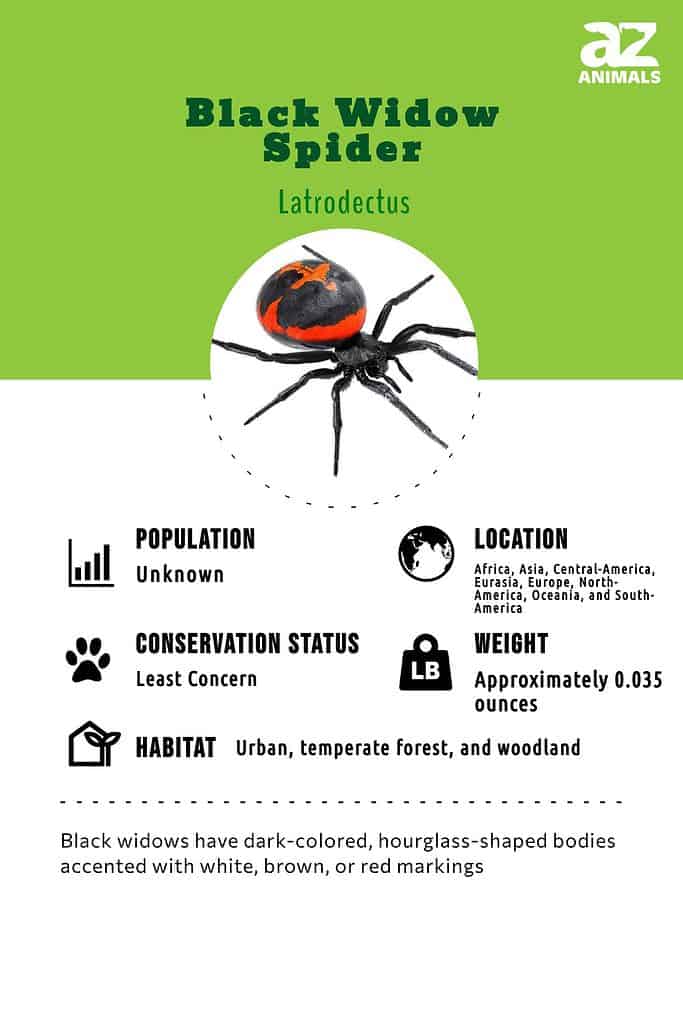
Scientific Name
Latrodectus is the scientific name for widow spiders. A portmanteau combining the New Latin word “latro,” meaning “bandit,” and the Ancient Greek word “dēktēs,” meaning “biter,” it was coined by French nobleman Baron Charles Athanase Walckenaer in the early 1800s. Colloquially, the name translates to “bandit who bites.”
Types
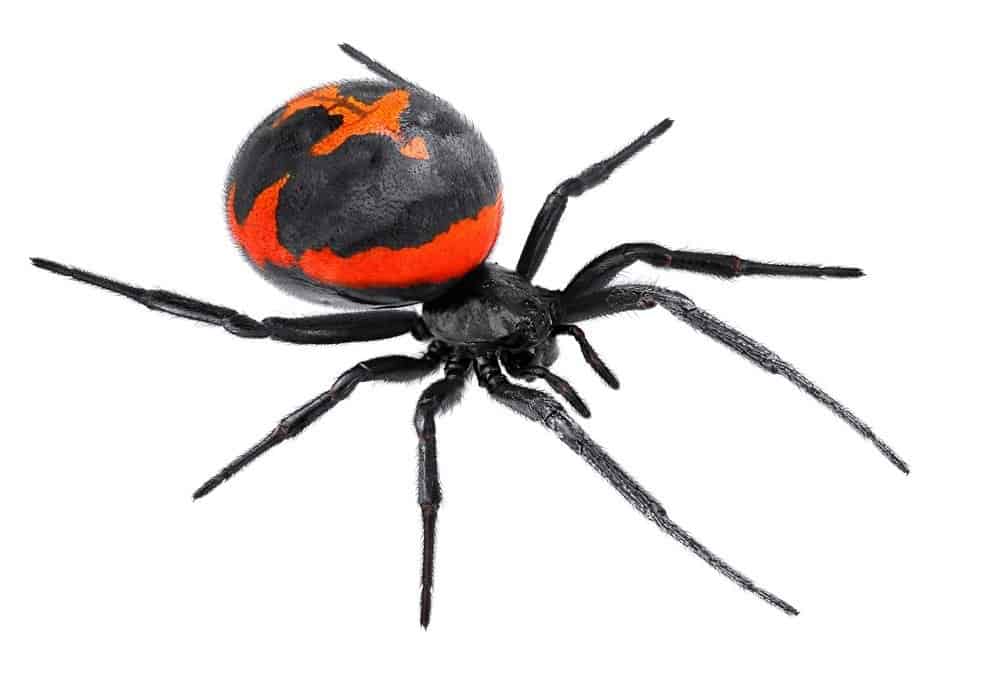
Members of the black widow genus can be found in Africa, the Americas, Asia, Australia, and Europe,
©Protasov AN/Shutterstock.com
There are 34 recognized species in the “true widow” genus. In North America, three species — Latrodectus mactans, Latrodectus hesperus, and Latrodectus variolus — are informally known as southern black widows, western black widows, and northern black widows, respectively. Latrodectus tredecimguttatus is the European black widow; Latrodectus hasseltii crawls throughout Australia and known as the redback black widow; in South America, two species — Latrodectus corallinus and Latrodectus curacaviensis — are commonly called South American black widow spiders.
| Scientific Name | Taxonomy Origin Date | Regions |
|---|---|---|
| Latrodectus antheratus | 1932 | Paraguay, Argentina |
| Latrodectus apicalis | 1877 | Galapagos Islands |
| Latrodectus bishopi | 1938 | USA |
| Latrodectus cinctus | 1865 | Cape Verde, Africa, Kuwait, Iran |
| Latrodectus corallinus | 1980 | Argentina |
| Latrodectus curacaviensis | 1776 | Lesser Antilles, South America |
| Latrodectus dahli | 1959 | Morocco to Central Asia |
| Latrodectus diaguita | 1960 | Argentina |
| Latrodectus elegans | 1898 | India, Myanmar, Thailand, China, Japan |
| Latrodectus erythromelas | 1991 | India, Sri Lanka |
| Latrodectus garbae | 2021 | Colombia |
| Latrodectus geometricus | 1841 | Africa, Introduced to North America and South America, Poland, Middle East, Pakistan, India, Thailand, Japan, Papua New Guinea, Australia, Hawaii |
| Latrodectus hasselti | 1870 | India, Southeast Asia to Australia, New Zealand |
| Latrodectus hesperus | 1935 | North America, Introduced to Israel, Korea |
| Latrodectus hurtadoi | 2021 | Colombia |
| Latrodectus hystrix | 1890 | Yemen |
| Latrodectus indistinctus | 1904 | Namibia, South Africa |
| Latrodectus karrooensis | 1944 | South Africa |
| Latrodectus katipo | 1871 | New Zealand |
| Latrodectus lilianae | 2000 | Spain, Algeria |
| Latrodectus mactans | 1775 | Probably native to North America only, Introduced to South America, Asia |
| Latrodectus menavodi | 1863 | Madagascar, Comoros, Seychelles |
| Latrodectus mirabilis | 1876 | Argentina |
| Latrodectus obscurior | 1902 | Cape Verde, Madagascar |
| Latrodectus pallidus | 1872 | Cape Verde to Libya, Turkey, Kazakhstan, Iran, Central Asia |
| Latrodectus quartus | 1980 | Argentina |
| Latrodectus renivulvatus | 1902 | Africa, Yemen, Saudi Arabia, Iraq |
| Latrodectus revivensis | 1948 | Israel |
| Latrodectus rhodesiensis | 1972 | Southern Africa |
| Latrodectus thoracicus | 1849 | Chile |
| Latrodectus tredecimguttatus | 1790 | Mediterranean to China |
| Latrodectus umbukwane | 2019 | South Africa |
| Latrodectus variegatus | 1849 | Chile, Argentina |
| Latrodectus variolus | 1837 | USA, Canada |
Evolution and Classification
Black widows are Araneomorphae a category of spiders known for having chelicerae which cross each other. Within that vast collective, they also belong to the subgroup Theridiidae, which are also referred to as tangle-web spiders, known for their habit of spinning adhesive webs for the capture of prey and the bristles on the seventh segment of their back legs, known as the tarsus.
As members of the genus Latrodectus, they are known as true widows and are connected to their European and South American counterparts, brown widows, red widows, the Australian redback spider, etc.
These arachnids also share the ability to produce the neurotoxic venom known as latrotoxin, known to be especially potent and which in turn gives rise to latrodectism.
Appearance and Behavior
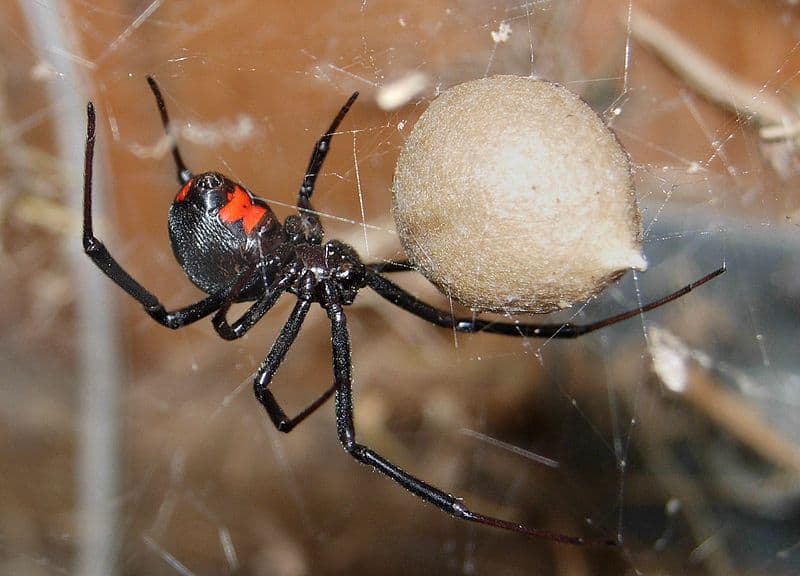
In spite of their small sizes, black widows produce a potent neurotoxic venom
©Chuck Evans(mcevan)”./ CC BY 2.5, via Wikimedia Commons – License
Nearly all black widow spiders are about 1.5 inches long, weigh approximately 0.035 ounces, and have dark-colored, hourglass-shaped bodies accented with white, brown, or red markings. Like most web-weaving spiders, widows have terrible eyesight and rely on vibrations to sense prey and danger.
Unlike the Goliath birdeater (Theraphosa blondi), the world’s largest spider, black widows are tiny — about the size of a paperclip. But don’t let their compact bodies fool you — because widows pack dangerous loads! Their bites release a neurotoxin called latrotoxin, which can cause extreme pain, muscle rigidity, vomiting, and heavy sweating. People bitten by black widow spiders may experience these symptoms for up to a week. But it’s false that widow bites routinely result in human fatalities. They do, however, kill cats and dogs.
Only females are harmful; males do not possess sufficient quantities of venom to cause signficant damage.
Widow spiders are notorious for female sexual cannibalism — meaning the ladies eat males after mating. But what people may not understand is that it doesn’t happen all that often, and not all species engage in the practice.
So why do some Latrodectus ladies murder their mates? Nobody knows for sure, but a popular theory postulates that the act increases the odds of offspring survival. Additionally, thanks to special chemicals that emanate from webs after meals, males can sense when females are well-fed, and most don’t choose hungry mates. In fact, most males who fall prey to their partners are trapped in a laboratory environment and can’t escape.
Habitat
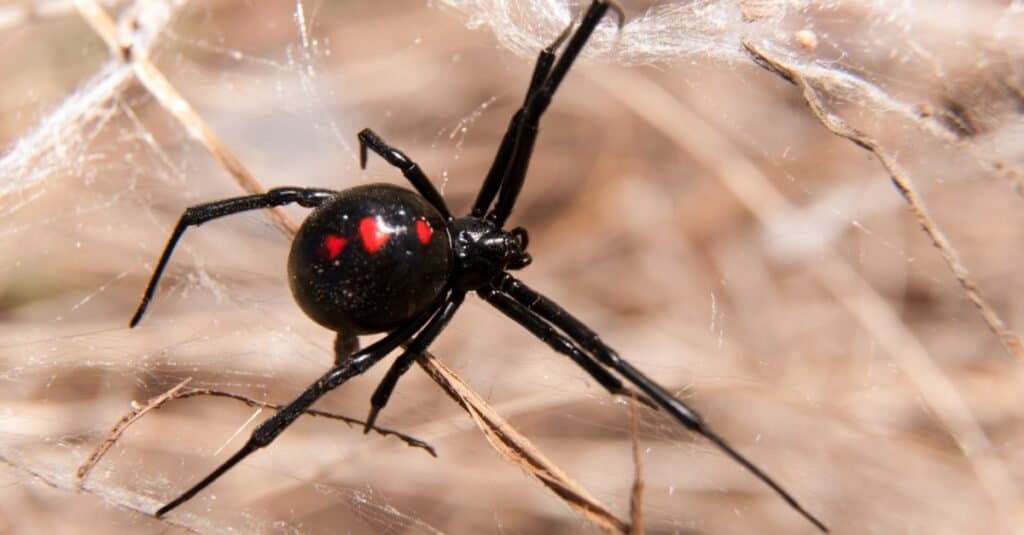
Black widows can be found in attics, basements or holes or woodpiles
©Sari ONeal/Shutterstock.com
Widow spiders crawl around every continent except Antarctica. They’re particularly abundant in North America, especially in Canada’s wine country, the Okanagan Valley in British Columbia.
Typically, black widow spiders spin webs near the ground or in dark, low places. Inside, you’ll most likely find them in dark corners under desks, basements, and attics. Outside, they hunker in holes and wood piles.
Diet
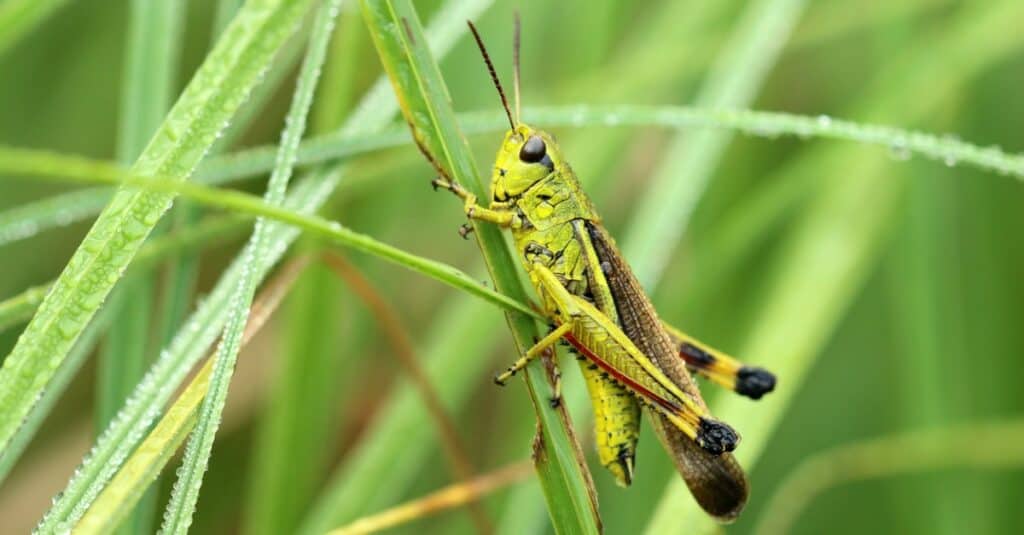
Grasshoppers are some of black widows favorite prey
©iStock.com/Eileen Kumpf
What do black widow spiders eat? They prey on small insects like flies, mosquitoes, grasshoppers, beetles, and caterpillars. Within their environment, you would consider them an apex predator.
How do black widows catch food? Like most other spider species, black widows weave sticky webs of silken fibers. When waiting for food to stumble into their lairs, widow spiders hang upside in the middle of their nets. When a victim crashes in, they’re incapacitated by the web’s stickiness. At that point, the spider converges, paralyzes the prey with venom, and then wraps its meal in silk to further prevent escape.
When a black widow is ready to dine, it covers its prey in erosive digestive juices and slurps up the remains. If a widow senses danger, it will quickly crawl down a loose web thread and scurry to safety.
Predators and Threats
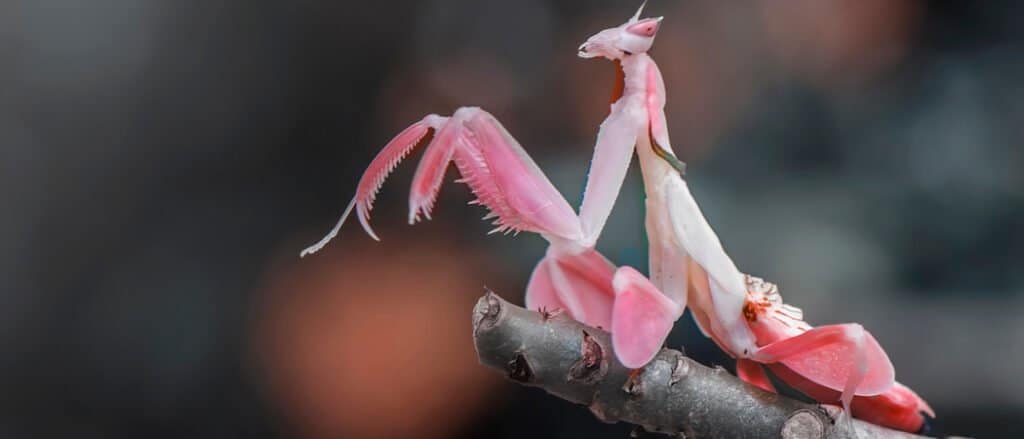
Praying mantises are an example of predator that black widows have to look out for
©Galuh M/Shutterstock.com
Few animals prey on black widow spiders because of the insects’ body shapes and markings, which scientists believe send unpleasant signals that repel most animals.
But rules come with exceptions, and in this case, the three are praying mantises (Mantodea), alligator lizards (Anguidae), and blue mud wasps (Chalybion californicum), which use their stingers to paralyze before chowing down.
Humans also pose a threat to black widow spiders because we accidentally crush them and purposefully kill them when stumbling upon the species at home.
Reproduction, Babies, and Lifespan
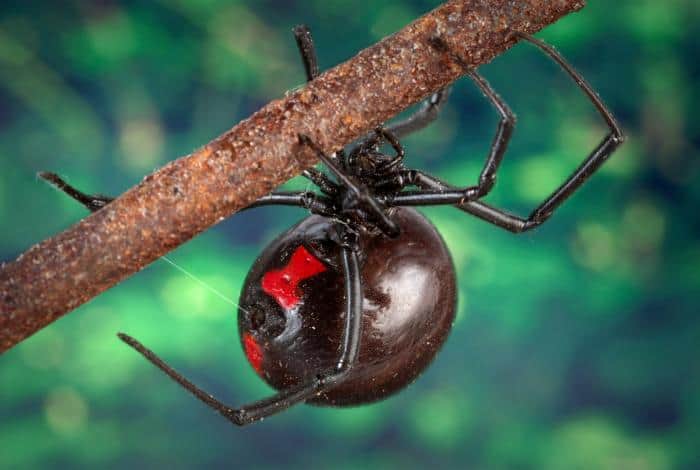
Black widow spiders generally get to live for three years
©James Gathany / public domain – License
Widow spiders are solitary animals that only come together in late spring for mating season. During the yearly ritual, males and females partner up, and the former injects the latter with sperm. The ladies then fertilize their eggs internally and lay silken egg sacs.
The sac incubates for about 30 days, at which point a pod of self-sufficient spiderlings hatch. The moment they’re born, baby spiders scurry away from the nest. The wind often helps them along, and most find themselves far away from home within hours of birth.
But a black widow’s life isn’t long. Many die before they reach a month old, and few — mostly females — make it to three years old.
Population
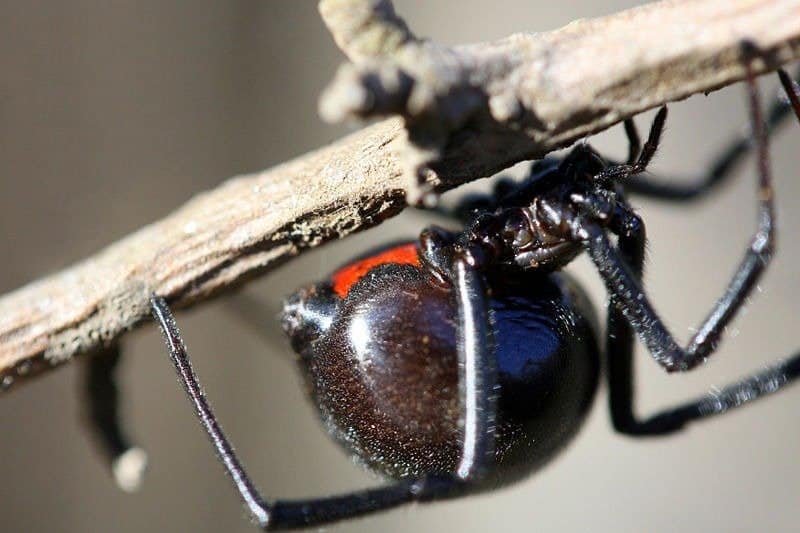
Black widow populations do not seem to be under any immediate threat
©Paul Sapiano / CC BY 2.0 – License
Black widow spiders aren’t in danger currently. The International Union for the Conservation of Nature doesn’t even include the animal on its Red List. IUCN does list false widow spiders, but only under the Data Deficient section.
Availability in U.S Zoos
Black widow spiders live in hundreds of exhibits and labs around the world. Here’s a partial list of U.S. zoos that care for individuals from the genus:
View all 285 animals that start with BBlack Widow Spider FAQs (Frequently Asked Questions)
Are black widow spiders herbivores, carnivores, or omnivores?
Widows eat other insects, which makes them carnivores.
Are Black Widow Spiders Dangerous to Humans?
In one sense, yes, they are. Female black widows carry heavy venom loads that sometimes cause illness and prolonged pain. On average, about 2,200 venomous black widow spiders bite people in the United States yearly, but the vast majority of attacks don’t result in hospitalization. In fact, no black-widow-related deaths have been reported to the American Association of Poison Control Centers since 1983.
Male widow spiders don’t pose a threat because they’re not poisonous. Moreover, most female bites are “dry bites,” meaning they don’t contain venom.
Can Black Widow Spiders Kill You?
Theoretically, yes, black widow spiders can kill — and have killed — humans! But you’re more likely to win the lottery than die from a black widow attack! However, exercise more caution in the Meditteranean, home of the Latrodectus tredecimguttatus, the most deadly black widow species of all.
Where Are Black Widow Spiders Found?
Globally speaking, species of the spider crawl around every continent except Antarctica. Locally speaking, black widow spiders tend to weave webs in undisturbed, dark areas, including wood piles, basements, and in the corners of seldom-used cabinets and furniture.
How Do You Kill a Black Widow Spider?
Black widow spiders can be eliminated in several ways.
To keep them from moving in, vacuum and dust regularly — even the basement and attic. Neglected woodpiles are like catnip to black widows, so clean them off weekly! Widow spiders smell through their feet and are repulsed by the scent of lemon, eucalyptus, tea tree oil, and peppermint. As such, if you’re on a mission to repel the spiders, use cleaning products infused with those aromas!
If a widow has already spun a web, aerosol and powdered pesticides sprayed or sprinkled directly on the spider or nest will kill it. Vinegar is an effective natural option. But natural doesn’t mean humane. Vinegar works because its acidity burns widows on contact — and that’s not a pleasant way to go, whether you’re a human or an insect.
For a less violent solution, make a home-made black widow repellent by combining equal parts vinegar and water in a spray bottle. Mist the corners of all your rooms and cabinets with the substance to keep the buggers at bay!
How Often Do Black Widow Spiders Bite?
Despite their ferocious reputations, black widow spiders aren’t big biters. When feasible, they prefer to avoid conflict and play dead. Their second-best defensive option is flicking silk at a threat. But when they’re trapped and have nowhere else to turn, they will attack. Male strikes are harmless because they don’t carry much venom. But a female bite can lead to a few uncomfortable hours for humans, and maybe death for dogs and cats.
What Kingdom do Black Widow Spiders belong to?
Black Widow Spiders belong to the Kingdom Animalia.
What phylum do Black Widow Spiders belong to?
Black Widow Spiders belong to the phylum Arthropoda.
What class do Black Widow Spiders belong to?
Black Widow Spiders belong to the class Arachnida.
What family do Black Widow Spiders belong to?
Black Widow Spiders belong to the family Theridiidae.
What order do Black Widow Spiders belong to?
Black Widow Spiders belong to the order Araneae.
What genus do Black Widow Spiders belong to?
Black Widow Spiders belong to the genus Latrodectus.
What is the main prey for Black Widow Spiders?
Black Widow Spiders prey on insects, woodlice, and beetles.
What are some predators of Black Widow Spiders?
Predators of Black Widow Spiders include wasps, birds, and small mammals.
What are some distinguishing features of Black Widow Spiders?
Black Widow Spiders have sharp fangs and shiny black and red bodies.
How many babies do Black Widow Spiders have?
The average number of babies a Black Widow Spider has is 250.
What is an interesting fact about Black Widow Spiders?
Black Widow Spiders typically prey on insects!
What is the scientific name for the Black Widow Spider?
The scientific name for the Black Widow Spider is Latrodectus.
How many species of Black Widow Spider are there?
There are 32 species of Black Widow Spider.
How do Black Widow Spiders have babies?
Black Widow Spiders lay eggs.
Who would win a fight between a black widow and a praying mantis?
A fully grown praying mantis would win a fight against a fully grown black widow.
What's the difference between a black widow spider and a brown widow spider?
There are some differences between brown widow spiders and black widow spiders, including their colors. Black widows are also more venomous than brown widows on average.
What's the difference between a black widow spider and a redback spider?
The main differences between black widow spiders and redback spiders are their geographical locations and appearances. Redback spiders have more red on their bodies, while black widows grow larger than redback on average.
What's the difference between a black widow spider and a brown recluse spider?
The main differences between black widows and brown recluses are their colors and habitats. Black widows are found around the world, while brown recluses are only found in certain states in the United States.
What's the difference between a male and a female black widow spider?
There are many differences between male and female black widows, including their markings and sizes. Male black widows are brown or gray, while females are always jet black.
Who would win a fight: Tarantula Vs Black Widow?
The tarantula would win a fight against the black widow due to its size, defense mechanism, venom, and strength.
How to say Black Widow Spider in ...
Thank you for reading! Have some feedback for us? Contact the AZ Animals editorial team.
Sources
- David Burnie, Dorling Kindersley (2011) Animal, The Definitive Visual Guide To The World's Wildlife
- Tom Jackson, Lorenz Books (2007) The World Encyclopedia Of Animals
- David Burnie, Kingfisher (2011) The Kingfisher Animal Encyclopedia
- Richard Mackay, University of California Press (2009) The Atlas Of Endangered Species
- David Burnie, Dorling Kindersley (2008) Illustrated Encyclopedia Of Animals
- Dorling Kindersley (2006) Dorling Kindersley Encyclopedia Of Animals
- Welke, Klaas W.; Schneider, Jutta M. (1970) "Sexual cannibalism benefits offspring survival". Animal Behaviour. 83 (1): 201–207.
- Baruffaldi, Luciana; Andrade, Maydianne C.B. (2015) "Contact pheromones mediate male preference in black-widow spiders: avoidance of hungry sexual cannibals?". Animal Behaviour. 102: 25–32.
- Osborne, H. Black widow spider silk is so strong a lab version could be used to build bridges., Available here: https://www.newsweek.com/black-widow-spider-silk-so-strong-lab-version-could-be-used-build-bridges-1184683
- Garwood, R. J., & Dunlop, J. Three-dimensional reconstruction and the phylogeny of extinct chelicerate orders. , Available here: https://www.ncbi.nlm.nih.gov/pmc/articles/PMC4232842/
- Harris, R. Predators of the Black Widow, Available here: https://animals.mom.com/predators-black-widow-7755.html

















